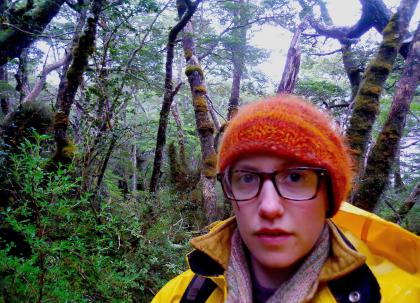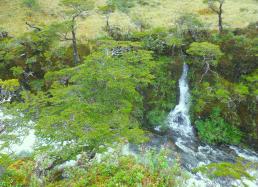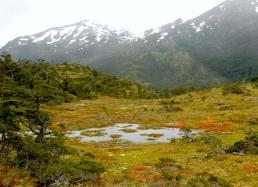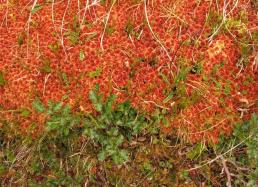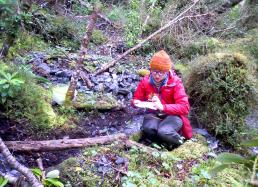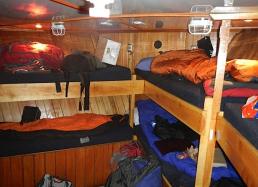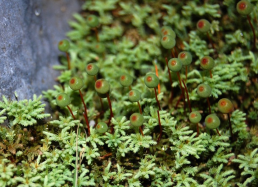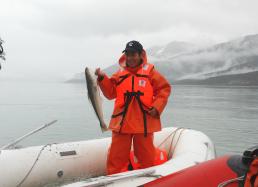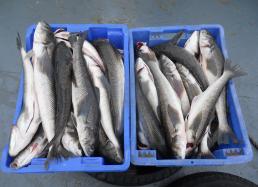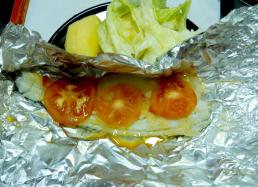Blog #3: Eyesight & Identification
Yesterday we revisited a site from the 2012 expedition, an old-growth forest made up of Southern Beech (Nothofagus species). I spent almost all my time collecting in these woods last year and was able to get just a glimpse of the area above the forest, where it opens up into a completely different landscape. So this time I quickly hiked through the trees and headed straight for the boggy meadow, a type of habitat known as Magellanic moorland (see Photos #1-4 below.)
Frustratingly, my vision seemed very blurry in the field, and I was unable to focus on anything! I thought it was just my hand lenses fogging up, a common annoyance of working in humid environments. But when I returned to the ship, I still couldn’t focus on anything. The culprit? Probably the Dramamine still in my system. This seems to be a nasty side effect from the at-times necessary medication for motion sickness.
The Next Day….
Two half-days of fieldwork are behind us. We hit two oceanic sites on our way navigating eastward (check out the "Beautiful Bryophytes" Photo Gallery for photos of the species we found there), but we’re now heading to our main destination. Hopefully, heading east will mean we’ll also be reaching drier land. But if the first two sites are any indication, everything seems flooded. We frequently found ponds with flooded margins where many normally terrestrial species were growing fully submerged. We’ve had rain both days, but somehow the second day has been much more comfortable in the field (see Photo #5 below.) Perhaps I’m just re-learning the ropes with my rain gear and remembering how relative “comfort” really is here.
The work takes on an additional challenge with the search for very specific species targeted for the micrograph project mentioned previously. In the field, looking for these species makes me a little slower because I must take my time to identify specimens as I collect them (normally I would just bag them and worry about identification later.) So far, we’ve already started off with great success and have found a few of our target species every day. But I still have a nagging feeling that I’m leaving precious specimens behind….
I’m now sitting at breakfast, indulging in fresh-baked bread with butter, membrillo (a jelly-like paste made from quince), honey, jam, and of course, the ubiquitous Nescafe. Danilo, the new cook, pulled several more packages of membrillo out of nowhere. I have the feeling that this delicacy was among the last-minute provisions bought in Punta at the request of Blanka and myself.
When I awaken in the mornings, it’s so dark in the bunkroom that I feel almost drugged and disoriented (see Photo #6 below.) I must’ve slept close to ten hours last night, but it was still a struggle to get out of bed. It’s now after 8:00 a.m., but only four of us are up and eating breakfast. You’d think we’d be more eager to get out into the field. But it’s still the beginning of the trip, and I think we’re all still getting our “sea legs.” (To see our at-sea living conditions, check out my "Video Journal #4: Touring the Ship.")
Later that Day….
It’s very strange to be in human-occupied spaces and hike along well-trod horse-trails. We’ve set anchor here at the Estancia Yendagaia, where we’ll stay the night and charter horses to travel to the Serka Glacier tomorrow morning. The gauchos say that the trip will be around three hours each way—an adventure, to be sure!
The collecting this morning wasn’t very exciting for me. Almost all mosses, and the few liverworts were nothing too special. Blanka, however, was overjoyed to find many healthy populations of Philonotis, a genus of mosses she’s specializing in (see Photo #7 below.)
The good news is that my vision has completely recovered. Since we’re anchored in one spot, and because my collecting this morning didn’t feel very productive, Blanka, Juan, and I decided to stay behind this afternoon to work on taking photographs under the microscope. This decision paid off, as we were able to completely finish the backlog.
Plus, staying behind on the boat meant we were treated to a snack of fresh gelatin cake, made by our ever-impressive cook. And tonight for dinner, we’ll eat the Robalo (a fish that lives in brackish waters) that Ramon caught today. The crew filled an entire chest freezer with filleted Robalo and will take the catch back to Punta Arenas to sell (see Photos #8-10.)
More soon,
Laura

